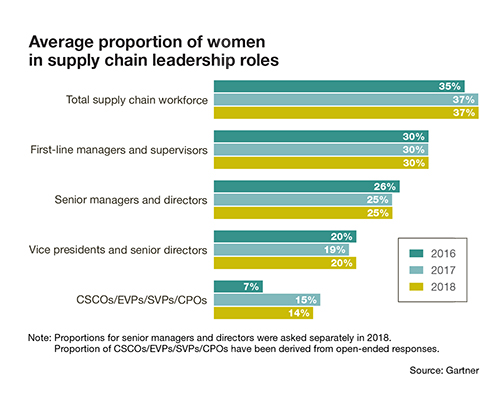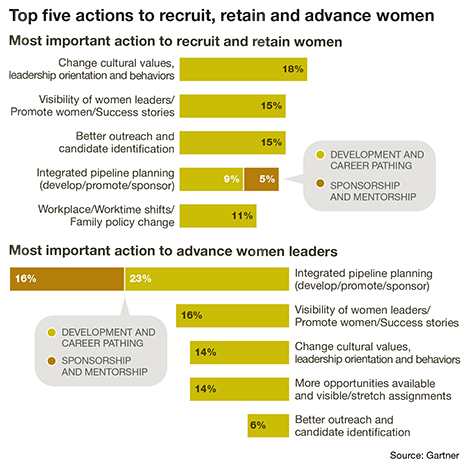Women In The Supply Chain: How Far Have We Come?
A Big Picture look at the inroads women are making in the supply chain field and what still needs to happen to increase their numbers in employee and senior leadership roles.
When Marie Fournier started using technology to automate supply chain functions back in the late-1970s, one of the more compelling pieces of equipment was a simple billing machine that could print invoices. Next came scanners for capturing orders, printers for generating tickets, and software for managing inventory—all of which helped reduce the need for manual processes and human intervention.
As technology advanced, the availability of automated tools for handling supply chain processes expanded right along with it. But through it all, Fournier remained one of the few women who worked in two fields that were largely dominated by men: IT and supply chain.
“Being in meetings and on sales calls, I was usually the only woman,” recalls Fournier, director of product marketing and business development for Tecsys. “Networking at conferences was extremely difficult and is even still intimidating for me today—namely because most of them are still 80% men.”
Undaunted, Fournier says if she had a daughter getting into supply chain today, she’d tell her to explore supply chain management, with a particular emphasis on business process improvement and inventory planning and optimization.
“It’s probably easier—or more expected—for women to be more on the supply chain management side versus supply chain execution,” says Fournier. “I see a higher number of women in the warehouse today, but I don’t how many female warehouse managers there actually are.”
Strong and sustained
Fournier isn’t alone. Look around at any supply chain- or logistics-oriented trade show these days and women still remain largely outnumbered on the expo floor, in educational sessions and at networking events. Even so, Gartner’s third-annual “Women in Supply Chain Survey” reveals sustained representation of women in the senior-most ranks of supply chain organizations, with more supply chain leaders spearheading their own initiatives to attract, retain and advance women.
According to the research firm, which conducts the survey with the organization AWESOME, representation of women in the senior-most ranks (i.e., CSCO, SVP, EVP, or CPO reporting to the CEO) is “strong and sustained” year over year relative to other functions. AWESOME (Achieving Women’s Excellence in Supply Chain Operations, Management & Education) is the supply chain’s most active and prominent organization focused on advancing women’s supply chain leadership.
Dig a little deeper in the numbers, however, and there’s clearly still a lot of work to be done. In fact, female representation remains low and constant at all other levels of leadership, Gartner reports. Dana Stiffler, Gartner research vice president, says that over the last two years “things have largely remained flat” for women in supply chain leadership positions.
 “We’re still in a place where women account for on average 37% or 38% of the average supply chain organization,” says Stiffler. “Then, as you go through the different levels of leadership, that percentage kind of drops off.”
“We’re still in a place where women account for on average 37% or 38% of the average supply chain organization,” says Stiffler. “Then, as you go through the different levels of leadership, that percentage kind of drops off.”
Currently, the proportion of women in executive roles in supply chain (i.e., a head of supply chain who reports directly to the CEO or president) is 14% (down from 15% last year). While this number may seem low, Gartner calls it a “healthy and even market-beating showing” compared with other functions, such as finance and accounting.
That number could have been influenced by the high number of survey respondents who participate in AWESOME, and who by their very nature hold high-level positions. “When these women are such a huge part of our sample,” says Stiffler, “it skews our leadership numbers a bit.”
Making strides
On a positive note, Stiffler says more companies are making an effort to attract a higher number of women to supply chain management and leadership positions. “With an eye on diversity and inclusion, they’re really focusing on some of those top supply chain jobs,” says Stiffler, “and we see that reflected in the report’s data.”
For example, more survey respondents are leading their own initiatives to attract more women to supply chain jobs rather than solely relying on enterprise-level human resources efforts. Of the supply chain organizations that have goals to increase the number of women in supply chain, for example, 60% say the supply chain organization has targeted initiatives to recruit, develop, retain and/or advance women in supply chain. This is up from 44% in 2017, according to Gartner.
“We definitely see more companies making a targeted effort to have more diversity and inclusion at the board and senior leadership levels,” says Stiffler. “They are focusing in on some of those top jobs, and those efforts are reflected in this year’s data.”
Tisha Danehl, vice president at recruiting agency Ajilon in Chicago, works with a lot of those companies, and says that the “longest job streak on record” is pushing more of them to polish their recruiting strategies.
As part of that effort, Danehl says companies are getting more intentional about putting women in the pipeline for open positions; avoiding any unconscious bias that may exist (i.e., using only male hiring managers); creating better women-focused talent retention programs (e.g., making it easier for women who recently started families to continue working on a more flexible basis); and using female mentors who can help shepherd the next generation of leaders to success.
“With more companies feeling the pain of not having a large candidate pool to pick from, we’re seeing more of them developing, promoting and sponsoring women in supply chain,” says Danehl. “That will help fuel women’s progress in the field.
Areas of improvement
This year, Gartner added two questions to its survey to highlight what it will take to improve recruiting and retention outcomes, as well as what will result in more women being offered and advancing into top jobs.
It asked:
- In your opinion, what is the most important thing your organization can do to improve recruiting and retention of women in the supply chain organization?
- And, what is the most important thing your organization can do to more effectively advance women to top leadership levels in the supply chain organization?
 Respondents see “increasing the presence and visibility of senior women leaders” as one of the most important actions companies should take to impact the ability to better recruit and retain women (15%), and advance women to senior levels (16%). Other important actions that would help recruit and retain more women include: changing cultural values, leadership orientation and behaviors as well as better visibility of current women leaders (and their success stories). To advance women leaders, respondents suggest more career development and career pathing as well as increased opportunities for sponsorship and mentorship.
Respondents see “increasing the presence and visibility of senior women leaders” as one of the most important actions companies should take to impact the ability to better recruit and retain women (15%), and advance women to senior levels (16%). Other important actions that would help recruit and retain more women include: changing cultural values, leadership orientation and behaviors as well as better visibility of current women leaders (and their success stories). To advance women leaders, respondents suggest more career development and career pathing as well as increased opportunities for sponsorship and mentorship.
Recognizing that some companies do a very good job of building their female leadership pipelines and introducing candidates to the numerous opportunities in supply chain, Stiffler says a lot of firms are still more focused on other priorities. “Someone is probably breathing down their necks about quality, costs, service and everything else that supply chain managers are traditionally measured or rewarded on,” says Stiffler. “Because of this, talent development is not part of the mainstream discussion.”
The flywheel effect
From her vantage point as AWESOME’s first executive director (and current executive director emeritus), Nancy Nix has watched the progression of women in supply chain since she started out as a supply chain practitioner with the DuPont Company—before “it was even called supply chain,” she says. An educator in the Neeley School of Business at Texas Christian University, Nix helped build the school’s supply chain program during a time “when we were just beginning to focus on supply chain as a critical business process,” she adds.
Throughout her career, Nix says that—like most women in supply chain leadership positions—she’s felt like the “lone voice in the wilderness.” With few other women to connect with or lean on, she helped found AWESOME with the goal of creating a viable network for women in the industry. But even with these types of groups at their avail, and with the growing emphasis on creating a more diverse workplace, women still face some high hurdles on the path to success in supply chain, logistics and distribution.
“There are systemic problems that get in the way of the progress of women, and it’s not just based on things they could be doing differently,” says Nix. “It’s biases in the hiring and promotion system—or the fact that ‘I recognize a good leader as someone who looks and acts just like me.’ That’s the kind of bias that gets in the way.” That problem is particularly onerous in fields largely dominated by men, Nix says, and evidenced by the fact that “when you take a name off a resume and can’t discern whether the candidate is male or female, you get a far higher rate of selection of the female candidates.”
Even with those biases holding them back from advancing in supply chain, Nix is bullish on the opportunities that lie ahead for women who want to get into management and leadership positions.
“According to the Gartner/AWESOME survey, about 50% of companies are saying they can’t make progress in this area because it’s really not a business priority for them,” says Nix. “At this point, it’s just a matter of the companies that are continuing on the journey and creating a flywheel effect as a result. As we see more changes take place, we’ll see more change.”
Related Article: International Women’s Day 2019 - #BalanceforBetter | Breakthrough Moment for Women in Global Trade













